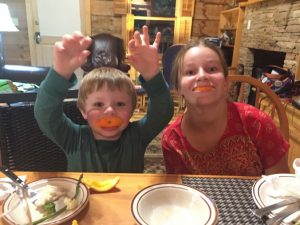 This story was written by Susan Perrow for use with young children (suggested ages 3-5 years) who are required to stay home during the current COVID-19 pandemic, or who have had their freedom severely modified (e.g. perhaps they can attend school but can’t attend special assemblies, festivals, parties or events).
This story was written by Susan Perrow for use with young children (suggested ages 3-5 years) who are required to stay home during the current COVID-19 pandemic, or who have had their freedom severely modified (e.g. perhaps they can attend school but can’t attend special assemblies, festivals, parties or events).
The song at the end has been left open for teachers and parents to create more verses with ideas from the children. The story can be changed/edited to suit different situations – e.g. mother tree could be father tree or grandmother or grandfather tree, or you may want to omit the part about ‘gnome school’. The main character could also be changed (e.g. instead of using a gnome the story could be about a mouse stuck in his little house, or a bird that must stay and rest in the nest).
The Little Gnome Who Had to Stay Home
Little gnome was confused.
Why did he have to stay home?
Didn’t everyone know how little gnomes love to roam!
He couldn’t go to gnome school, he couldn’t play with his friends in the forest, and his friends couldn’t visit him.
Little gnome was stuck in his tree-root home.
At least he could look out his window through the rocks and the tree roots. He was surprised that there was so much to see. Little ants were scurrying by, brightly coloured beetles were climbing up and down the fallen leaves and floppy eared rabbits were hopping in and out their burrows.
But even with all these things to watch, little gnome was growing impatient. Why did he have to keep on staying home? It didn’t make sense to him why he could not roam.
Then Mother Tree whispered to him:
‘Things are not as they used to be – but trust me – soon you will be free – trust me, trust me.’
Little gnome knew in his heart that he could always trust Mother Tree.
Mother Tree carried the wisdom of the whole forest!
Mother Tree knew all about everything. The birds and the wind were her friends and messengers.
They visited her every day sharing the news of the big wide world.
Little gnome could hear when the birds came by. He could hear them singing high up in the branches of Mother Tree.
Little gnome could see when the wind was visiting. He could see the branches swaying this way and that. He sometimes had to close his window to keep out the leaves and dust stirred up by this busy friend!
Everyday Mother Tree continued to whisper to him:
‘Things are not as they used to be – but trust me – soon you will be free – trust me, trust me.’
So little gnome had to trust, and little gnome had to wait. Soon he knew he would be free again to leave his home amongst the rocks and tree roots. Soon he knew he would be free to roam once again in the beautiful forest.
And while he waited, he was surprised how many things he could find to do in his cosy little tree root home.
Little gnome can dance
Little gnome can sing
Little gnome can paint and draw
And do somersaults across the floor.
Little gnome can dance
Little gnome can sing
Little gnome can clean and cook
And curl up with a picture book.
Little gnome can dance
Little gnome can sing
Little gnome can ………………………….
And ………………………………………………..
Little gnome can dance
Little gnome can sing
Little gnome can ………………………….
And ………………………………………………..
Little gnome can dance
Little gnome can sing
Little gnome can ………………………….
And ………………………………………………..
From the author:
I have chosen to write this story with a ‘mirroring’ structure – the story simply reflects the situation and expands upon it with images that help share a message that is too strong to state directly with little children. I haven’t promised any timeline because that would be irresponsible as no one knows it at this stage. The story’s aim is to encourage acceptance of the current ‘social distancing’ situation, and to help motivate the children to find and enjoy activities that they can do within the home.
For anyone new to ‘story medicine’, stories can help navigate the emotions that come with different kinds of loss and challenging situations. By allowing rather than resisting the truth, and by dressing it with the fabric of the imagination, stories can help the process of weaving the truth into everyday life, especially with young children.
This story will be included in the ‘loss of health and well-being’ section in my next book, entitled, ‘Stories to Light the Night: A Grief and Loss Collection for Children, Families and Communities’ (due to be published late 2020 by Hawthorn Press, UK) – the book will have more than 80 stories in different sections ….. stories for the loss of a loved one, loss of place, loss of family connection, loss of a pet, loss of health and well-being, loss of trust, and environmental grief and loss.
Printed with permission.
Thank you to Susan Perrow.
www.susanperrow.com

 Whether it’s a natural disaster, individual family trauma, or as now a pandemic, families can struggle when daily life is thrown upside down due to these events and the stress evades our every action and all our thoughts. Children are not immune to this and even infants and toddlers know that something worrying is happening. They will respond to the stress we are exhibiting which in turn raises our own struggles as parenting a stressed child is all the harder. It becomes a negative cycle and impacts all family members. So, what should we watch for in our littles to know how they are experiencing this and what we can do to limit the negative impact on them? By now we know how to wash our hands in order to keep our family physically healthy but how do we keep our young children (and thus ourselves) psychologically healthy?
Whether it’s a natural disaster, individual family trauma, or as now a pandemic, families can struggle when daily life is thrown upside down due to these events and the stress evades our every action and all our thoughts. Children are not immune to this and even infants and toddlers know that something worrying is happening. They will respond to the stress we are exhibiting which in turn raises our own struggles as parenting a stressed child is all the harder. It becomes a negative cycle and impacts all family members. So, what should we watch for in our littles to know how they are experiencing this and what we can do to limit the negative impact on them? By now we know how to wash our hands in order to keep our family physically healthy but how do we keep our young children (and thus ourselves) psychologically healthy? Behaviors we may see–
Behaviors we may see– Behaviors we may see–
Behaviors we may see– Behaviors we may see–
Behaviors we may see–